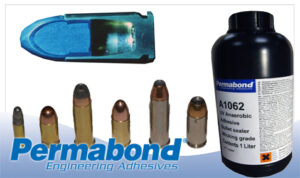
Bullets (or munitions) comprise several components including the actual bullet, casing, primer or pin and of course the explosive gun powder housed inside. Traditional methods of bullet sealing include use of a bitumous compound or lacquer. These are a fairly low-cost method of bullet sealing but are fairly messy, unpleasant to handle, are difficult to use on a high speed production line due to the cure time and have a limited shelf life once on the bullet (they can be prone to degrading, cracking off or allowing moisture ingress into the gunpowder).
Low viscosity anaerobic adhesives are another method allowing easier application, faster processing times, plus most importantly increasing the life and durability of the bullet. In fact, dual cure anaerobic-UV adhesives further extend this. They create an instant, impervious “fillet” or meniscus around the joint, it cures in seconds with UV light. Generally, these fluoresce under UV black light for inspection purposes. Anaerobic sealants are ideal for fully automated production lines, they are dispensed via automatic metered dosage to the bullet – normally in the horizontal position as they come rolling along the production line. The anaerobic sealant “wicks” into the gap between the bullet and the casing and reacts with the metal surface to cure.
Adhesives also seal the primer (at the back of the bullet) or the crimp on the tips of blank bullets. Material for this application has to be fully “friable” and pass NATO tests to ensure no adhesive particles can cause injury when blank bullets are fired.
For further information on bullet sealing, anaerobic sealant, or help selecting adhesives, please contact Permabond. Click here to download munitions brochure with product information.